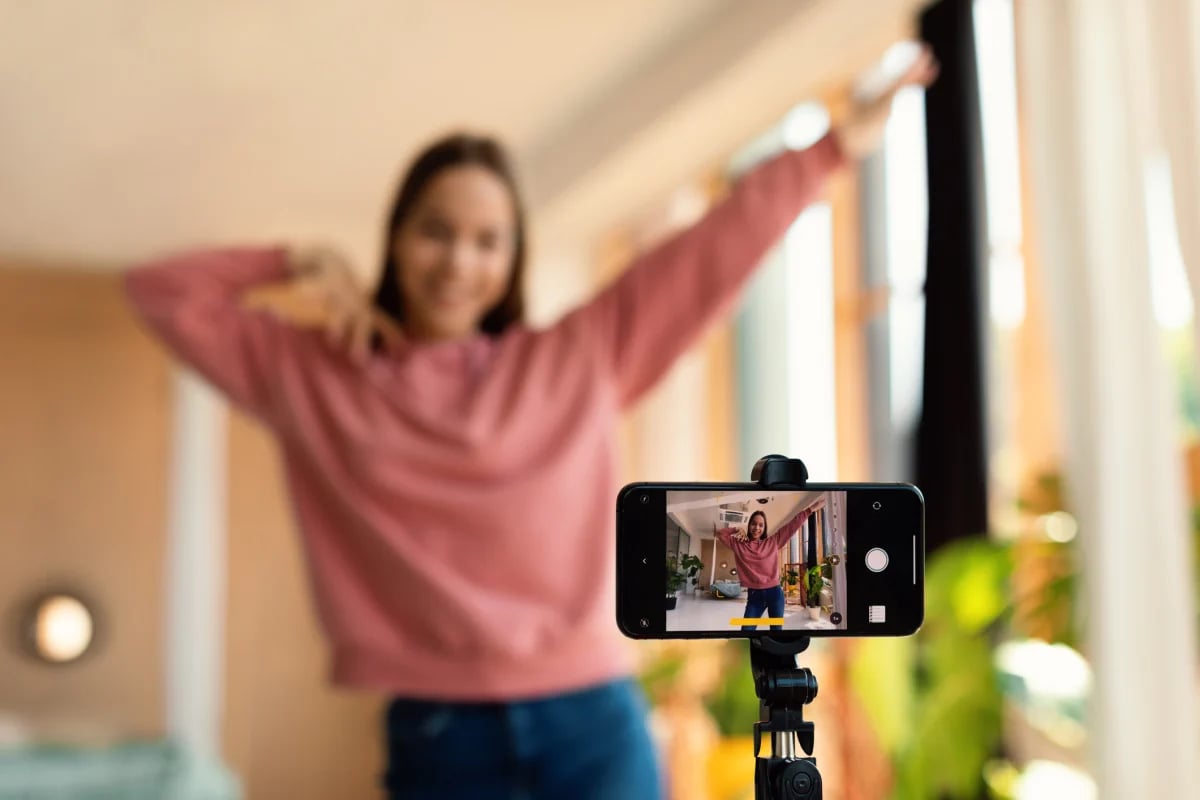Unlocking the Power of Video Transcoding
In today's digital era, video communication has become an integral part of our daily lives. Whether it's, live video streaming, conducting virtual meetings or sharing videos online, ensuring optimal video quality and compatibility is crucial.
This is where video transcoding comes into play. In the fast-paced world of digital media, transcoding plays a pivotal role in ensuring seamless streaming experiences, efficient file conversions and video format compatibility across devices and operating systems.
Table of Contents
- What is media transcoding?
- When should you transcode the video?
- How do you transcode video?
- Types of video transcoding
- Best practices for video transcoding
- The future of video transcoding
- Supercharge your video conferencing with Digital Samba’s VaaS and automated transcoding
In this article, we'll explore the world of video transcoding and uncover its significance in enhancing video streaming experiences.
What is media transcoding?
Media transcoding definition
Transcoding refers to the process of converting media files or video files from one format to another while preserving their content using a video transcoder. It involves decoding the original video file and re-encoding it into a different format, better suited for specific playback devices or streaming platforms. This transformation may include changes in parameters such as codecs, resolutions, bitrates, or container formats.
What is a video transcoder?
In simple terms, a video transcoder can be described as a hardware component on a device’s board or software used for converting video format from one format into another. Video transcoders are typically used for over-the-top technology (OTT) or adaptive bitrate (as explained later), where you’d want to convert one master video into a multitude of other video formats and resolutions that are compatible with numerous devices.
Why is transcoding footage crucial?
Transcoding is crucial for media streaming platforms and content creators alike. However, for applications such as video conferencing, it’s particularly important given the diverse nature of devices used by users in a video conference session.
Adaptive video streams or video footage transcoding enhances user experience, making sure that all users can stream footage smoothly with minimal bandwidth and without running into buffering issues or incompatibility issues.
Beyond streaming, transcoding also plays a crucial role in file conversion. As we mentioned, different users use numerous devices with a plethora of operating systems and hardware capabilities. As such, by transcoding files into different formats you ensure that data shared on your platform is compatible with a wide range of devices and software.
When should you transcode the video?
In the world of video conferencing, video production and video streaming, knowing when to transcode your video can make or break your user experience. Numerous scenarios might need you to transcode your video, ranging from video quality, and device compatibility to handling bandwidth limitations.
Let’s have a look at some of these considerations.
Achieving optimal video quality
Let’s say you are streaming or holding a video conference with a 4K quality camera. In most cases, you’d also want your users to view or watch the stream with the same quality. However, given the diversity of your users’ devices and hardware requirements, this becomes a challenge. Transcoding becomes necessary in such a scenario.
Leveraging transcoding on your video conferencing or streaming platform, you can convert your video streams from one format or encode them into another by adjusting parameters such as resolution, bitrate and codec.
This will ensure that your participants enjoy seamless and consistent communication, as well as high-quality video streams regardless of their bandwidth limitations, internet speed or the device they are using.
Ensuring compatibility across devices
In addition to converting video streams from one format into another, it’s also important to ensure that the video format is compatible with your users’ varying software requirements and supported formats.
For instance, let’s say you just finished your virtual meeting on your Windows device and saved the video in WMV file format, a format that’s only compatible with Windows devices. Using a video transcoder such as Digital Samba’s VaaS product, you can transcode your video into an MP4 format which is accessible to different devices, apps and browsers.

Addressing bandwidth and streaming limitations
One of the major issues that video stream watchers or video conference participants face is bandwidth constraints or slow network connections leading to consistent buffering and low-quality videos.
By leveraging transcoding, you can optimise your video delivery, minimise buffering and enhance your users’ experience through smoother playbacks and bandwidth optimisation, especially if a user has an unstable network connection.
Bandwidth optimisation can also be achieved with an almost similar process known as transrating. However, transcoding is a better option since it reduces the video stream's file size and adjusts the codec or format to ensure video streams are compatible with a particular device or platform.
How do you transcode video?
Transcoding a video may seem like a complex process, but with the right video transcoder, tools and knowledge, it can be relatively straightforward.
Transcoding typically includes the following key steps:
Decoding
Processing
Encoding
Step-by-step procedure for transcoding a video
Select the transcoding software or tool
The first step is choosing the right video transcoder or VaaS platform, and tools that match your required and desired output format. There is a plethora of options available in the market, each offering its unique features and capabilities depending on the intended output format and device.
Import the source video
Next, simply upload your master video into a video transcoder.
Configure the transcoding settings
Once the master video is uploaded, you can adjust the video settings to match your desired parameters. These parameters will depend on the video transcoder of your choice and the target platform or device you want to play or stream the transcoded video on.
Start the transcoding process
Next, initiate the transcoding process and let the software or tool convert the video based on the specified settings. However, kindly keep in mind that some VaaS platforms offer automated transcoding allowing you to export a recorded video with your desired parameters.
Preview and verify the transcoded video
Once the transcoding process is complete, ensure you preview the resulting transcoded video to confirm the parameters have been applied successfully.
Export the transcoded video
Lastly, save the transcoded video file into your desired location and format for further usage or distribution.
Types of video transcoding
There are various techniques you can leverage with video transcoding to ensure that your video meets your users’ needs and hardware requirements.
By understanding these techniques and the types of video transcoding, you’ll have a better grasp of the best practices of video transcoding and why they are crucial, as illustrated in the next section.
Now, let’s have a look at some of the types of video transcoding.
Format specific transcoding
As the name suggests, format transcoding involves converting videos from one format to another, this could be converting the codec or the video file format to mention a few. Format transcoding ensures that your resulting video is compatible across numerous devices and platforms. Additionally, format transcoding lets you implement the correct codec and bitrate to produce videos with the best video quality.
Some popular video codecs or formats including the H.264 and H.265 offer efficient compression but vary in terms of playback quality and bitrate. We’ll cover an example in the next section.
Intraframe vs interframe transcoding
This involves adjusting the video parameters to match the use case, the video's motion, and the desired balance between quality and file size. This involves two transcoding processes:
- Intraframe transcoding: it maintains video quality since each frame is encoded independently, typically needs higher bitrates for the same quality since each frame is encoded independently, and is best suited for editing and post-production workflows, where preservation of quality is mission-critical.
- Interframe transcoding: it may offer a greater risk of video quality degradation but it can achieve the same quality at lower bitrates thanks to temporal compensation and it’s best suited for streaming and delivery, where smaller file sizes are more important than quality.
Resolution considerations
Resolution transcoding adjusts the video's resolution without changing the codec or format. It helps adapt videos to different screen sizes or bandwidth limitations.
This typically involves two transcoding processes - Lossless transcoding which preserves the original video quality but can result in larger file sizes, and Lossy transcoding which sacrifices some quality to achieve smaller file sizes but may not be suitable for use cases that prioritise image quality.
Best practices for video transcoding
To achieve optimal results when transcoding videos, it's important to follow best practices that ensure compatibility, quality, and efficient file management.
Here are some key guidelines to consider:
Selecting codecs
Always ensure you choose codecs that strike a balance between file size and visual quality. Popular options like H.264 and H.265 offer efficient compression while maintaining good playback quality. Also, consider the compatibility of the target devices or platforms when selecting codecs.
For instance, transcoding from H.264 into H.265 results in better compression efficiency, which means that it can achieve higher-quality video at lower bitrates and smaller file sizes.
Bitrate optimisation
Balancing video quality and file size is crucial when optimising the bitrate and resolution during video encoding. Two important features to keep in mind when transcoding your video are the type of content being encoded and your target audience.
For example, high-motion content like online gaming requires higher bitrate and resolution to capture the details and enhance user experience. On the other hand, more static scenes like streaming using social media platforms and social media posts use lower bitrate and resolution without affecting the overall quality. In most cases, a bitrate of 1,500 – 4,000 KB is suitable for 720p video, while 8,000 – 14,000 is more suitable for a 4K video.

Resolution considerations
One of the best ways to maintain high-quality resolution is through Adaptive bitrate resolution which allows you to break the video into small segments encoding each segment at different bitrates and selecting the appropriate quality level to showcase depending on your users’ network status in real-time.
Know your target audience and select the appropriate format
When producing video content or hosting video conferences, you must research the technical specifications, recommended settings and the video format that your users will view your stream and the device they’ll use.
Depending on the device and hardware capabilities, it’s best to modify your video content to match your users' devices' supported codec, screen size, and bandwidth.
Additionally, different platforms offer unique parameters and it’s up to you to ensure that the parameters provided match your target devices and platforms.
For instance, MP4 and WebM formats are widely supported video formats supported by most devices and platforms.
The future of video transcoding
Over the past decade, video content delivery has made remarkable strides, thanks to exciting innovations in video conferencing, online gaming, online streaming, and the overall quality of video content.
With the diverse hardware specifications in different devices, video transcoding has also evolved to offer seamless high-quality video content to all users independent of the device they use.
Today, the future of video transcoding and content delivery is brimming with fascinating advancements.
One of the game-changers is the revolution of AI. By harnessing AI algorithms, developers can create video transcoders that analyse and optimise video quality on the fly. These intelligent transcoders adapt to various devices, network conditions, and bandwidth requirements autonomously.
Advancements in hardware technology are also pushing the boundaries of transcoding. Faster encoding and decoding processes speed up the whole transcoding ordeal, making it more efficient and scalable.
Plus, cloud-based transcoding services are making waves. With pay-as-you-go models, streaming platforms can leverage cloud platforms for transcoding, improving scalability, reducing costs, and delivering adaptive streaming experiences.
These cutting-edge advancements in video transcoding technology hold tremendous potential for streaming platforms. They can supercharge video conferencing solutions, delivering exceptional video quality, adaptive streaming, and efficient resource utilization.
Supercharge your video conferencing with Digital Samba’s VaaS and automated transcoding
When it comes to video conferencing and streaming video quality, leveraging the right platform makes all the difference. With the right VaaS product, you can leverage the power of automatic video transcoding to align with your users’ devices as well as network and bandwidth requirements.
With Digital Samba Embedded, you can enjoy the benefits of optimised video quality, adaptive streaming, and effortless compatibility across devices. Sign up for a free account today and experience the seamless integration of video conferencing and automated transcoding.
Share this
You May Also Like
These Related Stories

Video Encoding vs Video Transcoding: What's the Difference?

Bridging Real-Time Streaming: Unveiling the synergy between RTMP and HTML5 video players


